 A LARGE part of the highly educated youth is now unemployed. After their studies, they wait for years for employment but are unable to find the desired employment. As a result, they plunge into extreme depression. As the latest Bureau of Statistics 2022 Labour Force Survey data show, the number of educated unemployed, with bachelor’s (pass) degree, after 2022 was about 800,000 and the joblessness rate among highly educated people with degrees from educational institutions is now 12. In 2016–17, the joblessness rate among the highly educated was 11.2, which means that the joblessness rate among the highly educated has increased compared with the past.
A LARGE part of the highly educated youth is now unemployed. After their studies, they wait for years for employment but are unable to find the desired employment. As a result, they plunge into extreme depression. As the latest Bureau of Statistics 2022 Labour Force Survey data show, the number of educated unemployed, with bachelor’s (pass) degree, after 2022 was about 800,000 and the joblessness rate among highly educated people with degrees from educational institutions is now 12. In 2016–17, the joblessness rate among the highly educated was 11.2, which means that the joblessness rate among the highly educated has increased compared with the past.
The latest Bureau of Statistics quarterly labour force survey of April-June 2023 says that almost 73.3 million people are engaged in labour force and 70.7 million people are engaged in work force; and, out of them, about 46.5 million are men and 24.2 million are women. However, the joblessness rate fell to 3.41 per cent in the April–June quarter from 3.51 per cent in the previous quarter. The national statistical office says that 2.5 million people were unemployed the in April–June quarter and of them, 1.67 million men and 830,000 women were jobless.
According to the International Labour Organisation definition, unemployed people above the age of 15 in the last 30 days are considered jobless if they have not had an opportunity to work for wages for even one hour in the last seven days.
In 2022, it came as a grim picture of how dire the employment situation has become in the wake of the Covid outbreak after a young man ‘advertised teaching for rice’. In fact, how big a crisis workless and depression can create was revealed in the young man’s ‘teaching for rice advertisement’. In fact, the youth reach the age of 28 to complete their studies. They can apply for one or two civil service intakes by 30 years of age. But the suspension of job tests amidst the outbreak and worries about the end of the age make the unemployed extremely depressed.
Post-Covid situation is somewhat normal but on the same day, four to five written examination dates are set and they took two examinations in the morning and afternoon. There are often complaints of one or two examination question papers being leaked. All in all, this pitiful state of joblessness plunges them into extreme despair. Young job seekers say that the hope they wanted to live is not possible because of the age limit. They will study in the future. If this happens, the other will not happen. Because of all such reasons, many young women were depressed.
The BBS survey data say that about 19 per cent of the highly educated unemployed in 2022 were women and the workless rate among the uneducated or less educated was relatively low. Moreover, 2.82 per cent of secondary graduates and 4.94 per cent of higher secondary graduates are unemployed. Overall, the workless rate in 2022 is 3.53. According to the report, joblessness rate is the highest among the youth — 1.69 million. Besides, among those aged 25–34 years, about 625,000 are jobless and among those aged 35 or above, 268,000 are jobless. Among those who were jobless as of 2022, about 153,000 had no formal education. The jobless who completed primary education are about 322,000, who completed the secondary education are about 739,000, who completed the higher secondary education are bout 536,000, who earned their university degrees are about 739,000.
According to a report, ‘Asia-Pacific Employment and Social Outlook 2018’ on regional employment by the International Labour Organisation, the joblessness rate among the highly educated in Asia and the Pacific region is the highest in Pakistan at 16.8 while the figure is 10.7 per cent or Bangladesh, which is the second highest among 28 countries in the region. It paints a picture of joblessness, youth employment, inactive youth rate, formal and informal employment, job satisfaction, etc in 28 countries of the region in 2000–2017. It also says that higher education no longer guarantees job. The more educated young people are, the more likely they are to be unemployed. In 2017, Bangladesh had the lowest worklessness rate of 1.8 among people who did not complete their primary education. The rate among people who have completed primary education is 3.5. Among those educated up to secondary level, the rate is 8.5 and among those with higher education, the rate is 10.7.
The ILO report says that Bangladesh had an overall worklessness rate of 3.3 in 2000. In 2010, it stood at 3.4 per cent and as of 2013, 2016 and 2017, this rate remains the same at 4.4 per cent. The worklessness rate in Bangladesh is 3.3 for men and 12.percent for women. According to the report, youth joblessness doubled from 2010 to 12.8 per cent in 2017. A large part of the youth of Bangladesh is inactive again. The young are not engaged in any kind of education, training and are not looking for work. The rate of such people among young men is 27.4 and among young women is 45.
A former president recently said at the convocation of a private university in January 2023 that high-educated joblessness is increasing because of substandard education. He said that those who wanted to do business had many potential sectors. But avoiding the business mentality of education is good for everyone. He also said that it did not matter how much the students learnt or how much they were qualified for employment.
In fact, although it is sad, ensuring the quality of education is one of the biggest challenges. It is very important to ensure the quality, transparency and accountability of educational institutions to develop the nation, build a better society and produce world-class graduates. Higher education is worthless without quality. Therefore, it must be ensured that higher education is not all about certificates. In the name of education, universities should not be turned into commercial institutions, he said. There are hundreds of private universities and this initiative of private-sector investors in the expansion of education, especially higher education, is commendable. As a result of the initiatives, the young students get an opportunity to be educated in modern education. However, we do not want private universities to run as charities. The same way again, we do not want to consider education as a product and turn the university into a commercial institution in the name of education. All parents and guardians suffer a lot and they even send the children to the university by spending what they have so that they can live well in the future and their children can live with dignity and become financially independent. But in most cases, their dreams remain elusive.
Today’s youth want to achieve something desired by pursuing various dreams. Most of them have a good job after their education, many of them have a beautiful life and if there is any interruption, they plunge into extreme depression. There is no denying that the post-Covid joblessness has become more pronounced. Young women are unable to find desired employment and depression is taking hold of them. We have to come out of this and we have to ensure quality education. Only then will the worklessness among the youth be removed.
New Age









